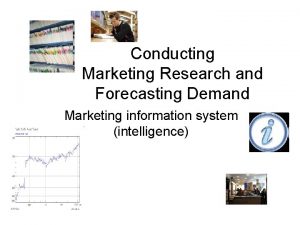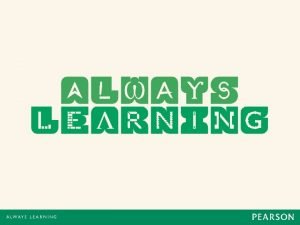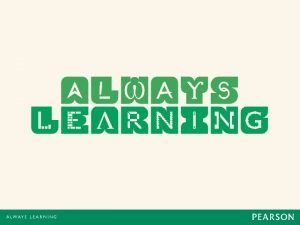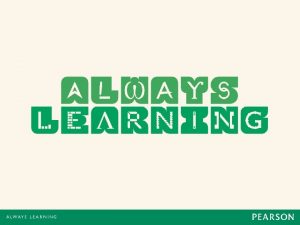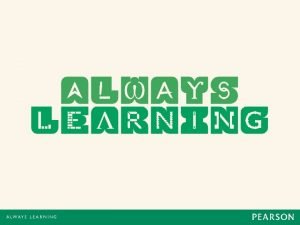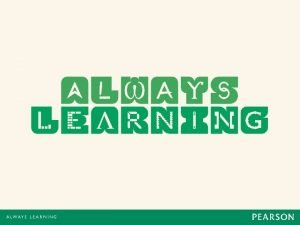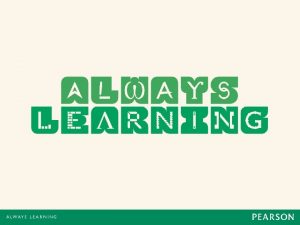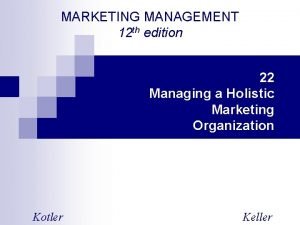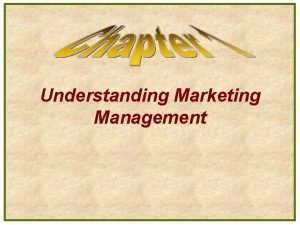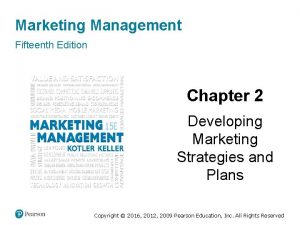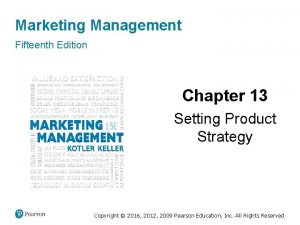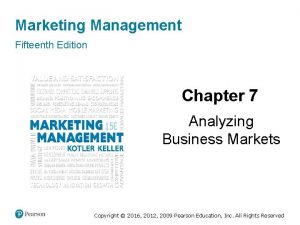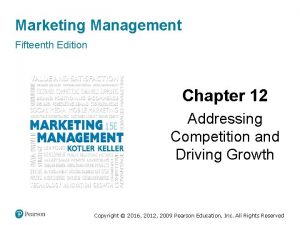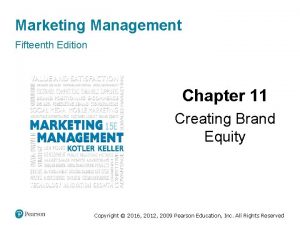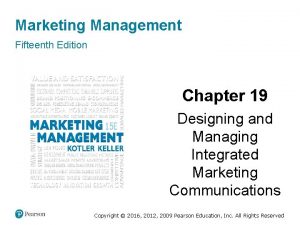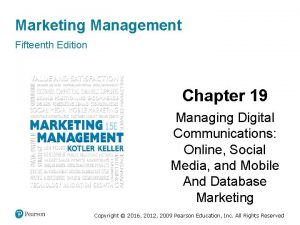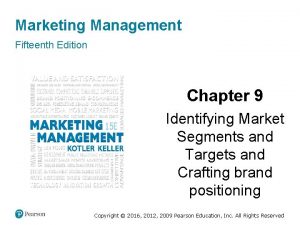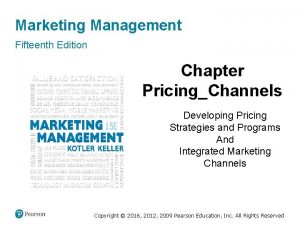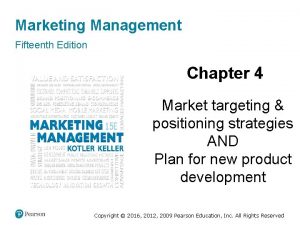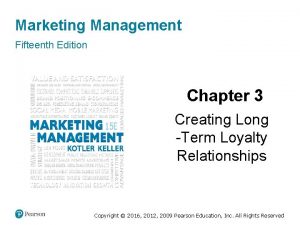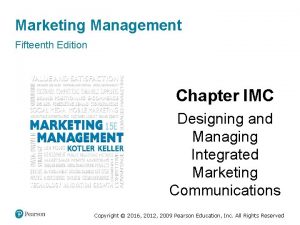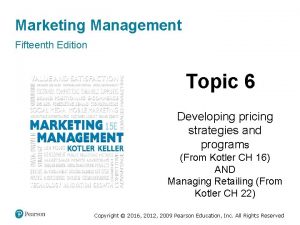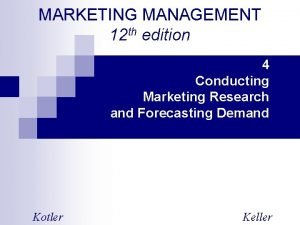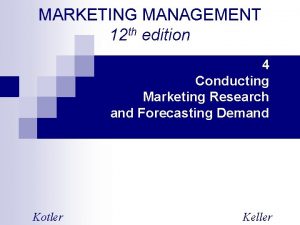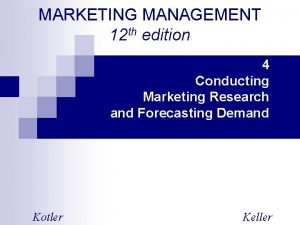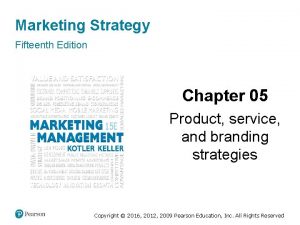Marketing Management Fifteenth Edition Chapter 4 Conducting Marketing













![Questionnaire (2 of 2) [Table 4. 1 continued] Copyright © 2016, 2012, 2009 Pearson Questionnaire (2 of 2) [Table 4. 1 continued] Copyright © 2016, 2012, 2009 Pearson](https://slidetodoc.com/presentation_image_h2/47bc917fb762a62d814bce60a1bced2f/image-14.jpg)







![Good Marketing Research (2 of 2) [Table 4. 2 continued] 5. Value and cost Good Marketing Research (2 of 2) [Table 4. 2 continued] 5. Value and cost](https://slidetodoc.com/presentation_image_h2/47bc917fb762a62d814bce60a1bced2f/image-22.jpg)







- Slides: 29

Marketing Management Fifteenth Edition Chapter 4 Conducting Marketing Research Copyright © 2016, 2012, 2009 Pearson Education, Inc. All Rights Reserved

Learning Objectives 4. 1 What is the scope of marketing research? 4. 2 What steps are involved in conducting good marketing research? 4. 3 What are the best metrics for measuring marketing productivity? Copyright © 2016, 2012, 2009 Pearson Education, Inc. All Rights Reserved

The Scope of Marketing Research (1 of 4) • American Marketing Association – Marketing research is the function that links the consumer, customer, and public to the marketer through information—information used to identify and define marketing opportunities and problems; generate, refine, and evaluate marketing actions; monitor marketing performance; and improve understanding of marketing as a process. Copyright © 2016, 2012, 2009 Pearson Education, Inc. All Rights Reserved

The Scope of Marketing Research (2 of 4) • Importance of marketing insights – Generating insights (how and why we observe certain effects in the marketplace) Copyright © 2016, 2012, 2009 Pearson Education, Inc. All Rights Reserved

The Scope of Marketing Research (3 of 4) • Who Does Marketing Research? ‒ Marketing departments in big firms ‒ Everyone at small firms ‒ Syndicated-service research firms ‒ Custom marketing research firms ‒ Specialty-line marketing research firms Copyright © 2016, 2012, 2009 Pearson Education, Inc. All Rights Reserved

Research Conducted at Small Companies • Engage students/professors • Tap employee creativity • Use Internet • Tap partner expertise • Check out rivals Copyright © 2016, 2012, 2009 Pearson Education, Inc. All Rights Reserved

The Scope of Marketing Research (4 of 4) • Overcoming Barriers to the Use of Marketing Research – Many companies still fail to use it sufficiently or correctly Copyright © 2016, 2012, 2009 Pearson Education, Inc. All Rights Reserved

Figure 4. 1 The Marketing Research Process Copyright © 2016, 2012, 2009 Pearson Education, Inc. All Rights Reserved

Step 1: Define the Problem, Define the Decision Alternatives, Define the Research Objectives Copyright © 2016, 2012, 2009 Pearson Education, Inc. All Rights Reserved

Step 2: Develop the Research Plan (1 of 6) • Data sources – Secondary data vs. primary data Copyright © 2016, 2012, 2009 Pearson Education, Inc. All Rights Reserved

Step 2: Develop the Research Plan (2 of 6) • Research approaches ‒ Observational research ‒ Focus group research ‒ Survey research ‒ Behavioral research Copyright © 2016, 2012, 2009 Pearson Education, Inc. All Rights Reserved

Step 2: Develop the Research Plan (3 of 6) • Research instruments – Questionnaires – Qualitative measures – Technological devices Copyright © 2016, 2012, 2009 Pearson Education, Inc. All Rights Reserved

Questionnaire (1 of 2) Table 4. 1 Types of Questions Copyright © 2016, 2012, 2009 Pearson Education, Inc. All Rights Reserved
![Questionnaire 2 of 2 Table 4 1 continued Copyright 2016 2012 2009 Pearson Questionnaire (2 of 2) [Table 4. 1 continued] Copyright © 2016, 2012, 2009 Pearson](https://slidetodoc.com/presentation_image_h2/47bc917fb762a62d814bce60a1bced2f/image-14.jpg)
Questionnaire (2 of 2) [Table 4. 1 continued] Copyright © 2016, 2012, 2009 Pearson Education, Inc. All Rights Reserved

Qualitative Measures • ZMET approach • Word association • Laddering • Projective techniques • Brand personification • Visualization Copyright © 2016, 2012, 2009 Pearson Education, Inc. All Rights Reserved

Step 2: Develop the Research Plan (4 of 6) • Technological devices – – – – Galvanometer Tachistoscope Eye-tracking Facial detection Skin sensors Brain wave scanners Audiometer GPS Copyright © 2016, 2012, 2009 Pearson Education, Inc. All Rights Reserved

Step 2: Develop the Research Plan (5 of 6) • Sampling plan – Sampling unit: Whom should we survey? – Sample size: How many people should we survey? – Sampling procedure: How should we choose the respondents? Copyright © 2016, 2012, 2009 Pearson Education, Inc. All Rights Reserved

Step 2: Develop the Research Plan (6 of 6) • Contact methods – – Mail Telephone Personal Online Copyright © 2016, 2012, 2009 Pearson Education, Inc. All Rights Reserved

Online Research • Advantages – – – Inexpensive Expansive Fast Honest Thoughtful Versatile • Disadvantages – – Small Skewed Excessive turnover Technological problems – Technological inconsistencies Copyright © 2016, 2012, 2009 Pearson Education, Inc. All Rights Reserved

Step 3 to Step 6 • Step 3: Collect the Information • Step 4: Analyze the Information • Step 5: Present the Findings • Step 6: Make the Decision Copyright © 2016, 2012, 2009 Pearson Education, Inc. All Rights Reserved

Good Marketing Research (1 of 2) Table 4. 2 The Seven Characteristics of good Marketing Research 1. Scientific method Effective marketing research uses the principles of the scientific method: careful observation, formulation of hypotheses, prediction, and testing. 2. Research creativity In an award-winning research study to reposition cheetos snacks, researchers dressed up in a brand mascot Chester Cheetah suit and walked around the streets of San Francisco. The response the Character encountered led to the realization that even adults loved the fun and playfulness of Cheetos. The resulting repositioning led to a double-digit sales increase despite a tough business environment. 3. Multiple methods Marketing researchers shy away from overreliance on any one method. They also recognize the value of using two or three methods to increase confidence in the results. 4. Interdependence of models and data Marketing researchers recognize that data are interpreted from underlying models that guide the type of information sought. Copyright © 2016, 2012, 2009 Pearson Education, Inc. All Rights Reserved
![Good Marketing Research 2 of 2 Table 4 2 continued 5 Value and cost Good Marketing Research (2 of 2) [Table 4. 2 continued] 5. Value and cost](https://slidetodoc.com/presentation_image_h2/47bc917fb762a62d814bce60a1bced2f/image-22.jpg)
Good Marketing Research (2 of 2) [Table 4. 2 continued] 5. Value and cost of information Marketing researchers shoe concern for estimating the value of information against its cost. Costs are typically easy to determine, but the value of research is harder to quantify. It depends on the reliability and validity of the findings and management’s willingness to accept and act on those findings. 6. Healthy scepticism Marketing researchers show a healthy skepticism toward glib assumptions made by managers about how a market works. They are alert to the problems caused by “marketing myths. ” 7. Ethical marketing Marketing research benefits both the sponsoring company and its customers. The misuse of marketing research can harm or annoy consumers, increasing resentment at what consumers regard as an invasion of their privacy or a disguised sales pitch. Copyright © 2016, 2012, 2009 Pearson Education, Inc. All Rights Reserved

Measuring Marketing Productivity • Marketing metrics • Marketing-mix modeling • Marketing dashboards Copyright © 2016, 2012, 2009 Pearson Education, Inc. All Rights Reserved

Marketing Metrics • Measures that help marketers quantify, compare, and interpret performance Table 4. 3 Sample Marketing Metrics I. External II. Internal Awareness of goals Market share (volume or value) Commitment of goals Relative price (market share value/volume) Active innovation support Number of complaints (level of dissatisfaction) Resource adequacy Consumer satisfaction Staffing/skill levels Distribution/availability Desire to learn Total number of customers Willingness to change Perceived quality/esteem Freedom to fail Loyalty/retention Autonomy Relative perceived quality Relative employee satisfaction Copyright © 2016, 2012, 2009 Pearson Education, Inc. All Rights Reserved

Marketing-Mix Modeling • Analyzes data from a variety of sources, such as retailer scanner data, company shipment data, pricing, media, and promotion spending data, to understand more precisely the effects of specific marketing activities Copyright © 2016, 2012, 2009 Pearson Education, Inc. All Rights Reserved

Marketing Dashboards • “A concise set of interconnected performance drivers to be viewed in common throughout the organization. ” ‒ Customer-performance scorecard ‒ Stakeholder-performance scorecard Copyright © 2016, 2012, 2009 Pearson Education, Inc. All Rights Reserved

Sample Customer-Performance Scorecard Measures Table 4. 4 Sample Customer-Performance Scorecard Measures • Percentage of new customers to average number of customers • Percentage of lost customers to average number of customers • Percentage of Win-back customers to average number of customers • Percentage of customers falling into very dissatisfied, natural, satisfied, and very satisfied categories • Percentage of customers who say they would repurchase the product • Percentage of customers who say they would recommend the product to others • Percentage of target market customers who have brand awareness or recall • Percentage of customers who say that the company’s product is the most preferred in its category • Percentage of customers who correctly identify the brand’s intended positioning and differentiation • Average perception of company’s product quality relative to chief competitor • Average perception of company’s service quality relative to chief competitor Copyright © 2016, 2012, 2009 Pearson Education, Inc. All Rights Reserved

Figure 4. 3 Example of a Marketing Dashboard Copyright © 2016, 2012, 2009 Pearson Education, Inc. All Rights Reserved

Copyright © 2016, 2012, 2009 Pearson Education, Inc. All Rights Reserved
 Human resource management fifteenth edition
Human resource management fifteenth edition Human resource management 15th edition
Human resource management 15th edition University physics with modern physics fifteenth edition
University physics with modern physics fifteenth edition The worlds of the fifteenth century
The worlds of the fifteenth century Chapter 12 the worlds of the fifteenth century
Chapter 12 the worlds of the fifteenth century 13 course french classical menu with examples
13 course french classical menu with examples Fifteenth amendment
Fifteenth amendment Chapter 29 conducting marketing research
Chapter 29 conducting marketing research What is forced choice questions
What is forced choice questions The marketing research process follows five steps
The marketing research process follows five steps Conducting marketing research and forecasting demand
Conducting marketing research and forecasting demand Conducting marketing research and forecasting demand
Conducting marketing research and forecasting demand Conducting marketing research and forecasting demand
Conducting marketing research and forecasting demand Marketing management (arab world edition) philip kotler
Marketing management (arab world edition) philip kotler What is the value delivery process
What is the value delivery process Marketing management (arab world edition) philip kotler
Marketing management (arab world edition) philip kotler Marketing management (arab world edition)
Marketing management (arab world edition) Marketing management (arab world edition) philip kotler
Marketing management (arab world edition) philip kotler Marketing management (arab world edition)
Marketing management (arab world edition) Marketing management 12th edition
Marketing management 12th edition Marketing management 12th edition
Marketing management 12th edition Using mis (10th edition) 10th edition
Using mis (10th edition) 10th edition Using mis (10th edition) 10th edition
Using mis (10th edition) 10th edition Management stephen robbins notes
Management stephen robbins notes Marketing meaning in marketing management
Marketing meaning in marketing management Objective of marketing manager
Objective of marketing manager Marketing definition
Marketing definition Defining marketing for the new realities
Defining marketing for the new realities Marketing for hospitality and tourism 7th edition ppt
Marketing for hospitality and tourism 7th edition ppt Marketing an introduction 6th canadian edition
Marketing an introduction 6th canadian edition












